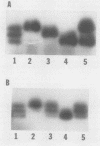Abstract
The plastid and cytosolic isozymes of the dimeric enzyme phosphoglucose isomerase (EC 5.3.1.9) from spinach (Spinacia oleracea) and cauliflower (Brassica oleracea) were purified to apparent homogeneity. The isozymes from sunflower (Helianthus annuus) and Clarkia xantiana were partially purified. When subunits from two electrophoretically distinguishable cytosolic isozymes, either from the same or from different species, were dissociated and allowed to reassociate in each other's presence, an active hybrid enzyme, consisting of one subunit of each type, was formed in addition to the two original homodimers. Active hybrid enzymes were also formed by dissociation and reassociation of plastid isozymes. Hybrid molecules were not produced between the plastid and cytosolic subunits, suggesting that they are not able to bind with each other. Additional differences between the plastid and cytosolic isozymes are described.
Full text
PDF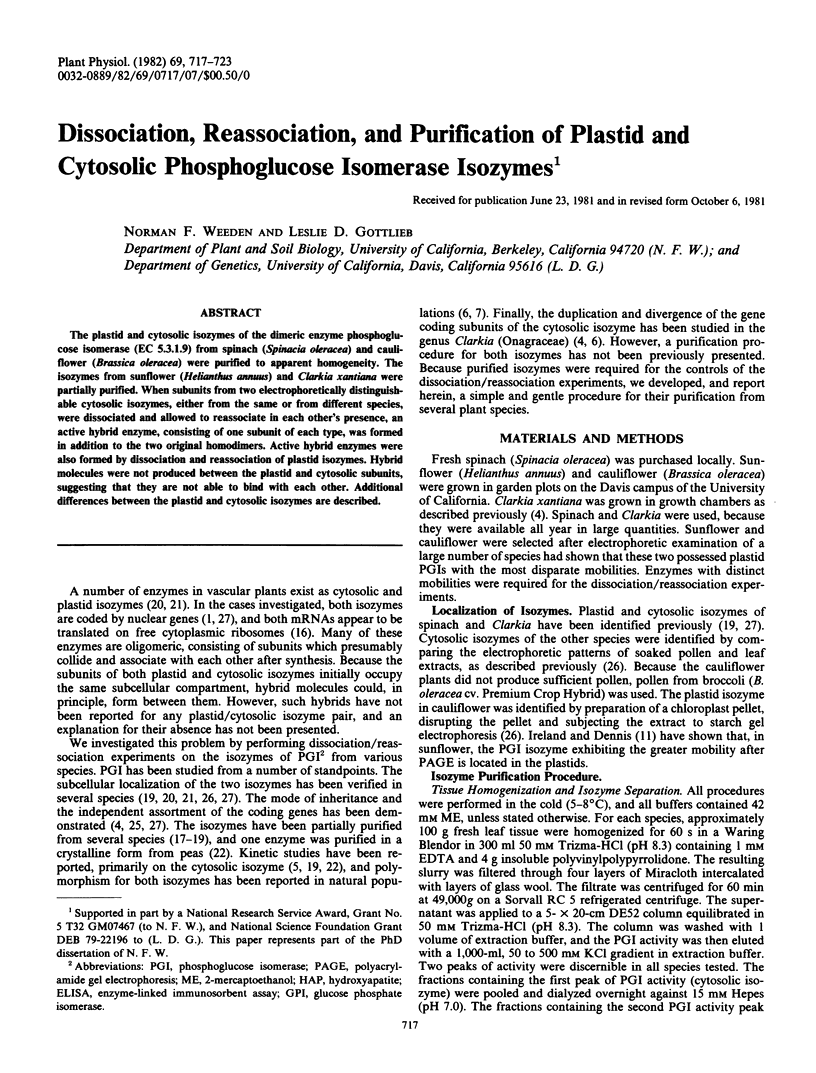
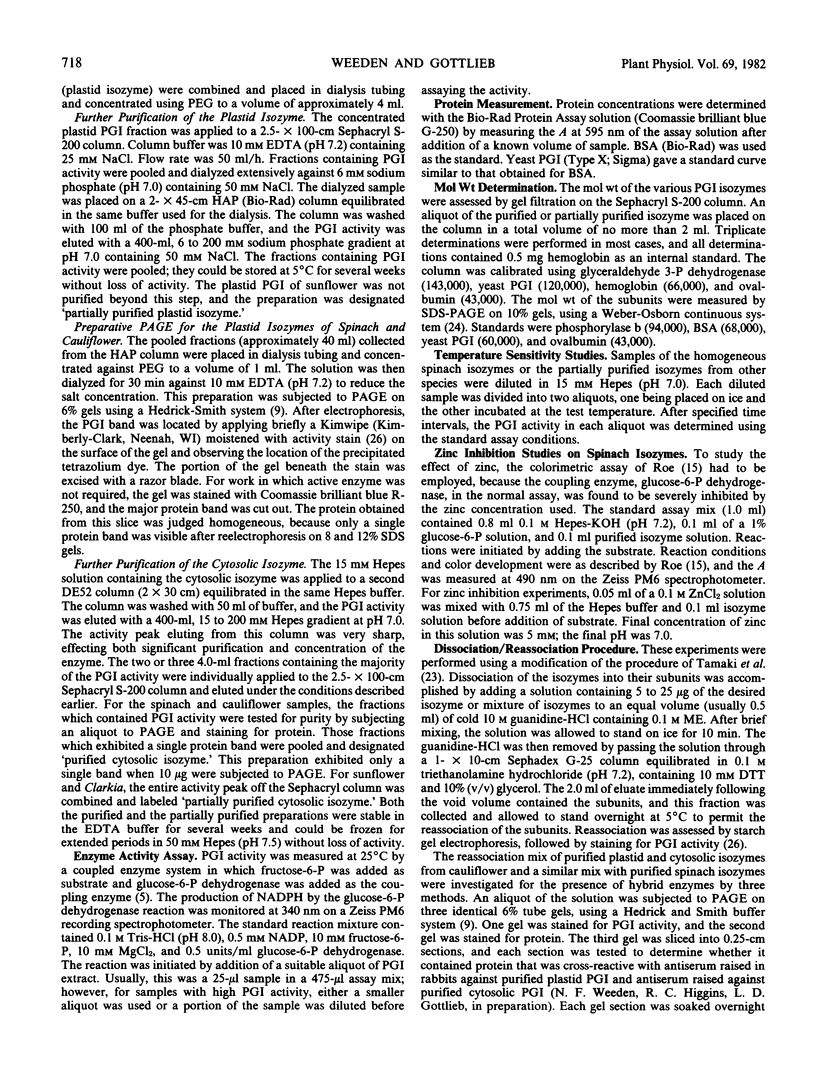
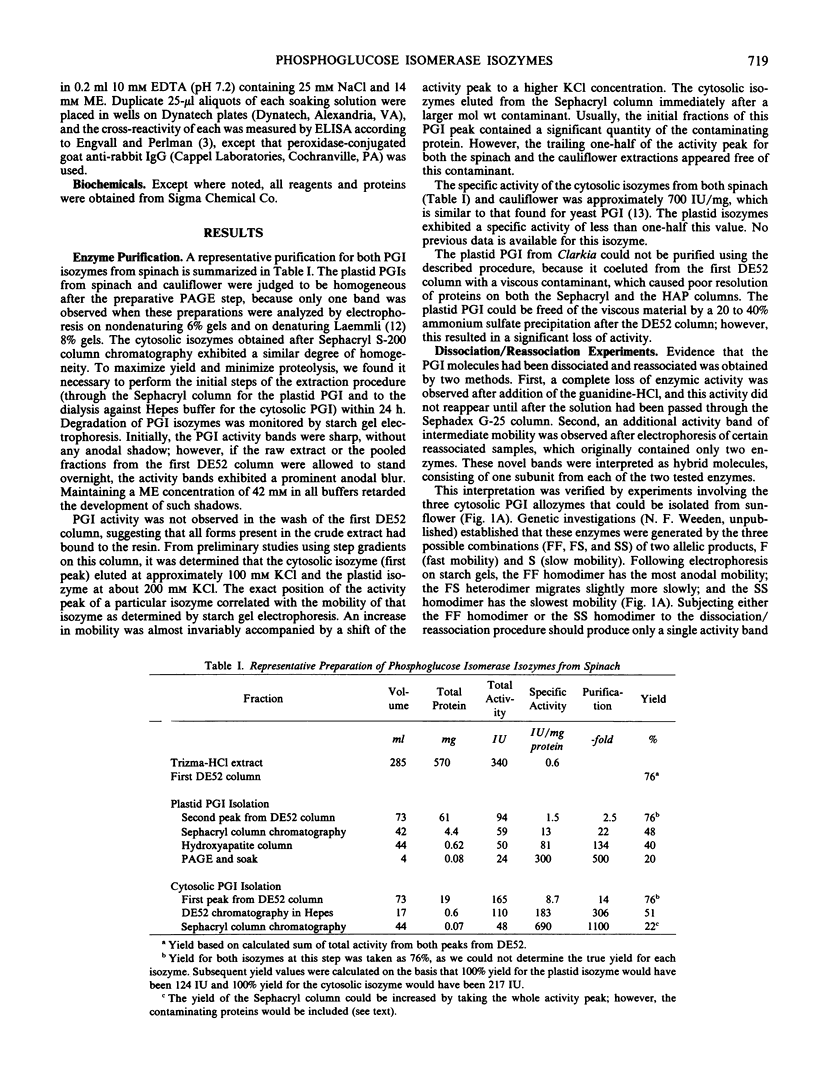
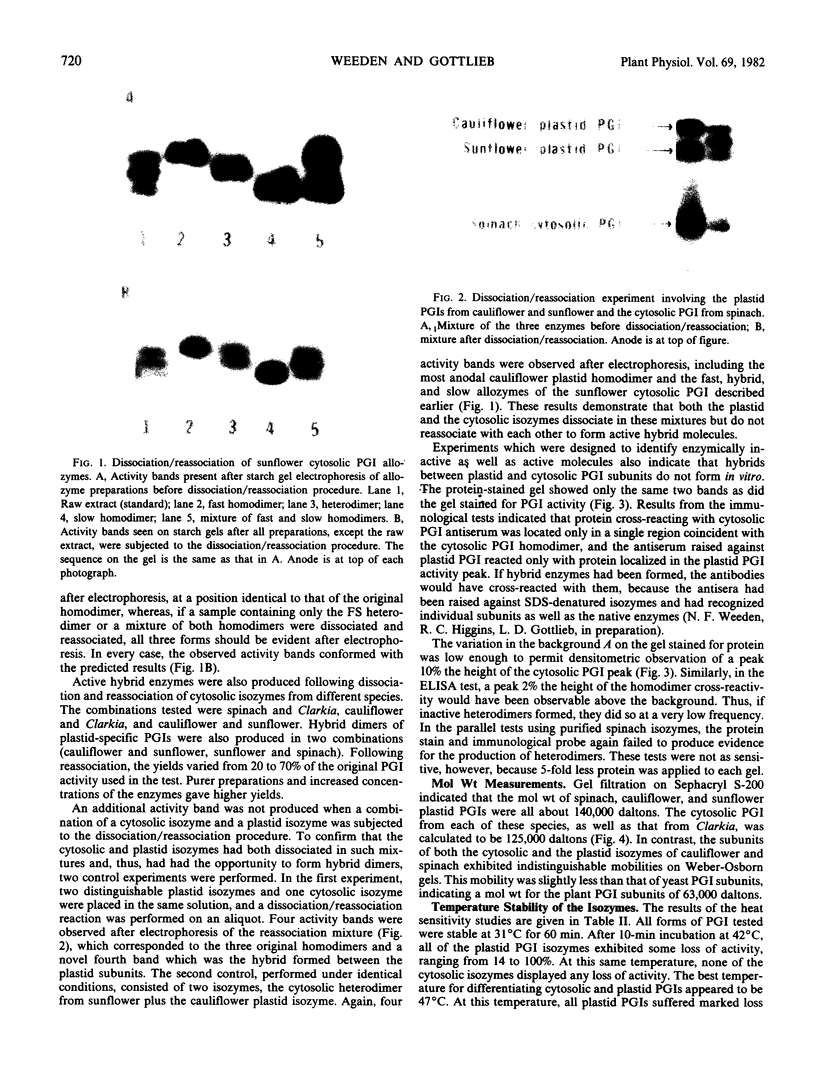
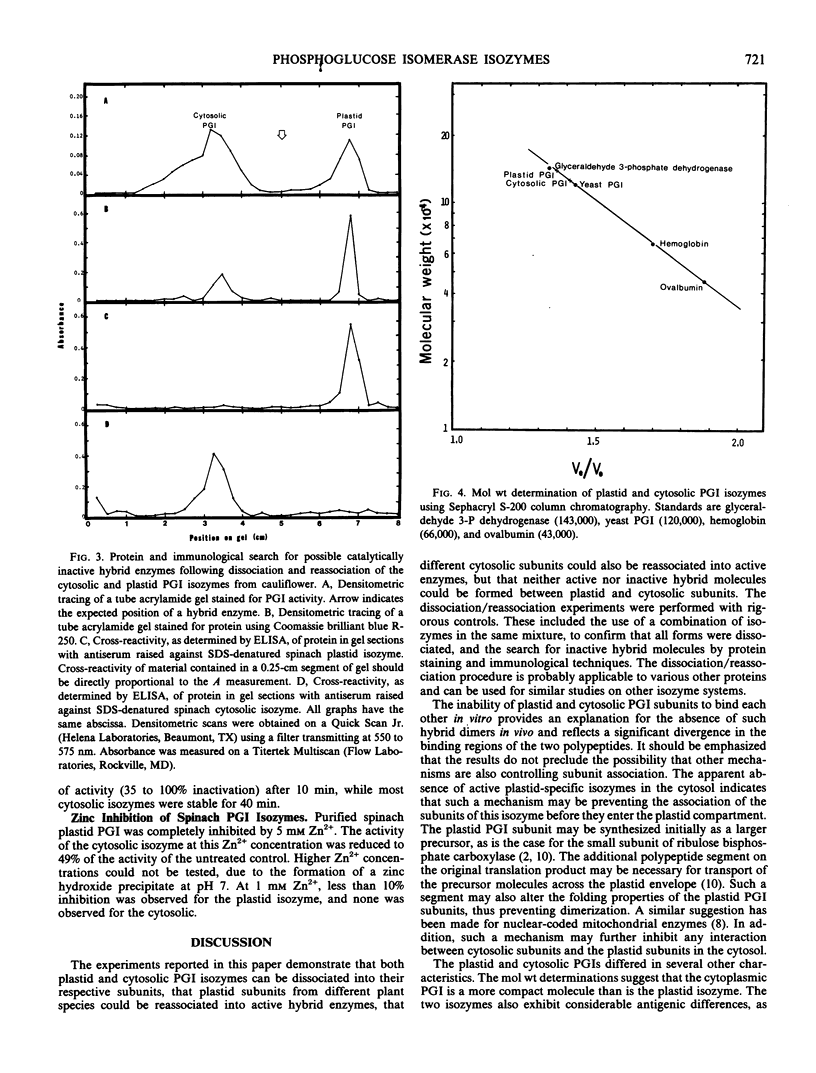
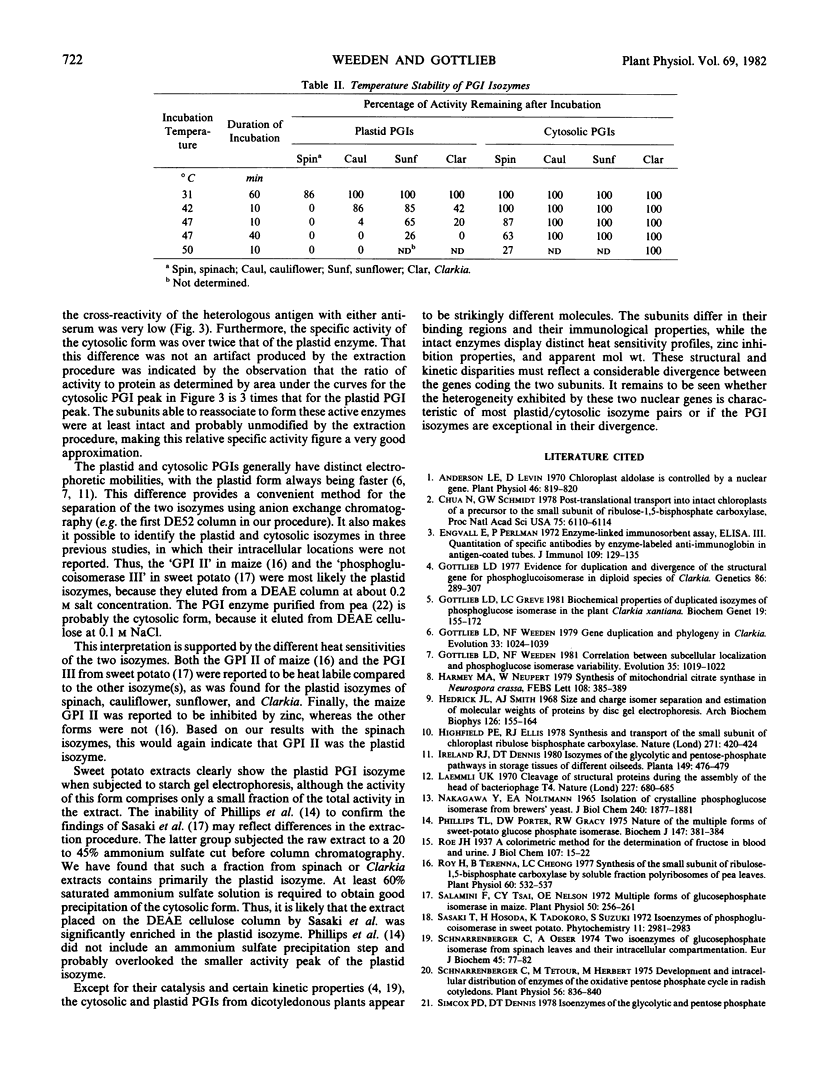

Images in this article
Selected References
These references are in PubMed. This may not be the complete list of references from this article.
- Anderson L. E., Levin D. A. Chloroplast aldolase is controlled by a nuclear gene. Plant Physiol. 1970 Dec;46(6):819–820. doi: 10.1104/pp.46.6.819. [DOI] [PMC free article] [PubMed] [Google Scholar]
- Chua N. H., Schmidt G. W. Post-translational transport into intact chloroplasts of a precursor to the small subunit of ribulose-1,5-bisphosphate carboxylase. Proc Natl Acad Sci U S A. 1978 Dec;75(12):6110–6114. doi: 10.1073/pnas.75.12.6110. [DOI] [PMC free article] [PubMed] [Google Scholar]
- Engvall E., Perlmann P. Enzyme-linked immunosorbent assay, Elisa. 3. Quantitation of specific antibodies by enzyme-labeled anti-immunoglobulin in antigen-coated tubes. J Immunol. 1972 Jul;109(1):129–135. [PubMed] [Google Scholar]
- Gottlieb L. D. Evidence for duplication and divergence of the structural gene for phosphoglucoisomerase in diploid species of clarkia. Genetics. 1977 Jun;86(2):289–307. doi: 10.1093/genetics/86.2.289. [DOI] [PMC free article] [PubMed] [Google Scholar]
- Gottlieb L. D., Greve L. C. Biochemical properties of duplicated isozymes of phosphoglucose isomerase in the plant Clarkia xantiana. Biochem Genet. 1981 Feb;19(1-2):155–172. doi: 10.1007/BF00486145. [DOI] [PubMed] [Google Scholar]
- Harmey M. A., Neupert W. Biosynthesis of mitochondrial citrate synthase in Neurospora crassa. FEBS Lett. 1979 Dec 15;108(2):385–389. doi: 10.1016/0014-5793(79)80569-4. [DOI] [PubMed] [Google Scholar]
- Hedrick J. L., Smith A. J. Size and charge isomer separation and estimation of molecular weights of proteins by disc gel electrophoresis. Arch Biochem Biophys. 1968 Jul;126(1):155–164. doi: 10.1016/0003-9861(68)90569-9. [DOI] [PubMed] [Google Scholar]
- Laemmli U. K. Cleavage of structural proteins during the assembly of the head of bacteriophage T4. Nature. 1970 Aug 15;227(5259):680–685. doi: 10.1038/227680a0. [DOI] [PubMed] [Google Scholar]
- NAKAGAWA Y., NOLTMANN E. A. ISOLATION OF CRYSTALLINE PHOSPHOGLUCOSE ISOMERASE FROM BREWERS' YEAST. J Biol Chem. 1965 May;240:1877–1881. [PubMed] [Google Scholar]
- Phillips T. L., Porter D. W., Gracy R. W. Nature of the multiple forms of sweet-potato glucose phosphate isomerase. Biochem J. 1975 May;147(2):381–384. doi: 10.1042/bj1470381. [DOI] [PMC free article] [PubMed] [Google Scholar]
- Roy H., Terenna B. Synthesis of the Small Subunit of Ribulose-1,5-bisphosphate Carboxylase by Soluble Fraction Polyribosomes of Pea Leaves. Plant Physiol. 1977 Oct;60(4):532–537. doi: 10.1104/pp.60.4.532. [DOI] [PMC free article] [PubMed] [Google Scholar]
- Salamini F., Tsai C. Y., Nelson O. E. Multiple forms of glucosephosphate isomerase in maize. Plant Physiol. 1972 Aug;50(2):256–261. doi: 10.1104/pp.50.2.256. [DOI] [PMC free article] [PubMed] [Google Scholar]
- Schnarrenberger C., Oeser A. Two isoenzymes of glucosephosphate isomerase from spinach leaves and their intracellular compartmentation. Eur J Biochem. 1974 Jun 1;45(1):77–82. doi: 10.1111/j.1432-1033.1974.tb03531.x. [DOI] [PubMed] [Google Scholar]
- Schnarrenberger C., Tetour M., Herbert M. Development and intracellular distribution of enzymes of the oxidative pentose phosphate cycle in radish cotyledons. Plant Physiol. 1975 Dec;56(6):836–840. doi: 10.1104/pp.56.6.836. [DOI] [PMC free article] [PubMed] [Google Scholar]
- Takeda Y., Hizukuri S., Nikuni Z. Crystallization and properties of pea glucosephosphate isomerase. Biochim Biophys Acta. 1967;146(2):568–575. doi: 10.1016/0005-2744(67)90241-0. [DOI] [PubMed] [Google Scholar]
- Tamaki N., Hess B., Ikeda T., Kimura K., Hama T. Mild purification procedure and subunit structure of glucosephosphate isomerase from baker's yeast. Hoppe Seylers Z Physiol Chem. 1980 Jan;361(1):61–68. doi: 10.1515/bchm2.1980.361.1.61. [DOI] [PubMed] [Google Scholar]
- Weeden N. F., Gottlieb L. D. Distinguishing allozymes and isozymes of phosphoglucoisomerases by electrophoretic comparisons of pollen and somatic tissues. Biochem Genet. 1979 Apr;17(3-4):287–296. doi: 10.1007/BF00498969. [DOI] [PubMed] [Google Scholar]
- Weeden N. F., Gottlieb L. D. Isolation of cytoplasmic enzymes from pollen. Plant Physiol. 1980 Sep;66(3):400–403. doi: 10.1104/pp.66.3.400. [DOI] [PMC free article] [PubMed] [Google Scholar]



